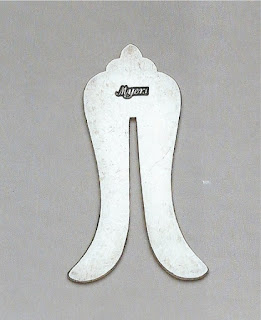I apply for and go to two types of shows. One is the large scale national craft show, such as the Philadelphia Museum of Art Craft show which I will be participating in this fall. To a show such as that I take a mixture of judaica and non-judaic metalwork, such as teapots, serving pieces and some small sculptures. The other type of show I attend is geared to judaica. These are shows sponsored by temples, synagogues or jewish organizations, To these I take only judaica. The show last week fell into this later category.
This show was a boutique at the national conference of a major jewish woman’s organization. Over 1000 attendees were expected. This was an ideal show for me. It had a targeted audience, was 3 days long, and located in a closed environment, a hotel. Additionally it had reasonable fees (per table) plus a percentage of sales.
I arrived the day before the boutique was to open and was ready to set up early the next morning. I arranged my tables and began the process of unpacking and setting up my inventory. For a show such as this I bring a variety of judaica - 40-50 mezzuzot in different sizes and finishes, kiddush cups with a wide price range, shabbos candlesticks, havdalah sets and individual pieces, menorahs and dreidels, a few hamsas and other judaic jewelry, yads, and a few specialty items such as tzedakah boxes, two handled hand washing pitchers and torah breast plates. It takes a couple of hours to get everything unpacked and arranged. At the same time I am talking with other vendors who I know as well as introducing myself to those I haven’t met.
After set up, I returned to my room, took a quick nap and changed clothes in anticipation of an early afternoon start. As a vendor I can only ask that the show’s sponsor get the people to the door. Getting attendees to look, engaging them, and ultimately to buy is uniquely my responsibility. The afternoon session was characterized by people looking, asking questions and saying that it is early and they would be back.
After a break for the organizations evening function the show reopened with a dessert bar in the area adjacent to the show. That’s great. It brings people into the boutique’s venue while they are having a positive experience. Again traffic was strong. a few sales, lots of interest.
The next two days were characterized by short burst of activity and longer periods of slow, limited foot traffic. This was a densely programmed conference. Good for the organization and the attendees, not so good for me.
In the late afternoon of the third day the boutique closed. I packed up, took my boxes to the shipper. After a shower and change I headed out to dinner with a law school classmate and his wife whom I hadn’t seen in 10-12 years. Next morning, the airport and home.
Retail is the toughest part of being a metalsmith. Being a closer is not something that comes easily to me. Ultimately I did not do as well as I had expected. At the same time a sale that fell through at the last moment would have changed the entire show’s complexion.
PIECE OF THE MONTH
This is my Mogan David Kiddush Cup. I believe it is one of the best designed pieces I have made. It is my best selling kiddush cup, sterling silver, approximately 2.5 x 2.5 x 2.25”.
The piece begins as a 4” 20 gauge sterling silver disk which I have spun into a cup 2” tall and 2” wide at the top. The piece is then forged into the triangular shape which forms the goblet of the piece. I do this over a stake which I have modified to have a tapered flat surface which allows me to form the angles of the sides. Once the cup is trued it is inverted onto a piece of flat 20 gauge sterling and its rim is scribed into the sterling. That piece is cut out and cleaned up to form the base.
The cup is centered on the base and soldered with hard solder. After pickling, three feet are added at the points of the base. They are made with a Roper Whitney punch. The small pieces are domed and a hole drilled in them to allow for air to escape during final soldering. The feet are then sweat soldered onto the base.
Cleanup and polishing follow. The last act, as always, is to place my mark and sterling stamp on the bottom of the piece.
You can see this piece and the rest of my judaica at www.jimcohenjudaica.com. My non-judaic work is featured at www.jimcohenmetals.net. ENJOY!





